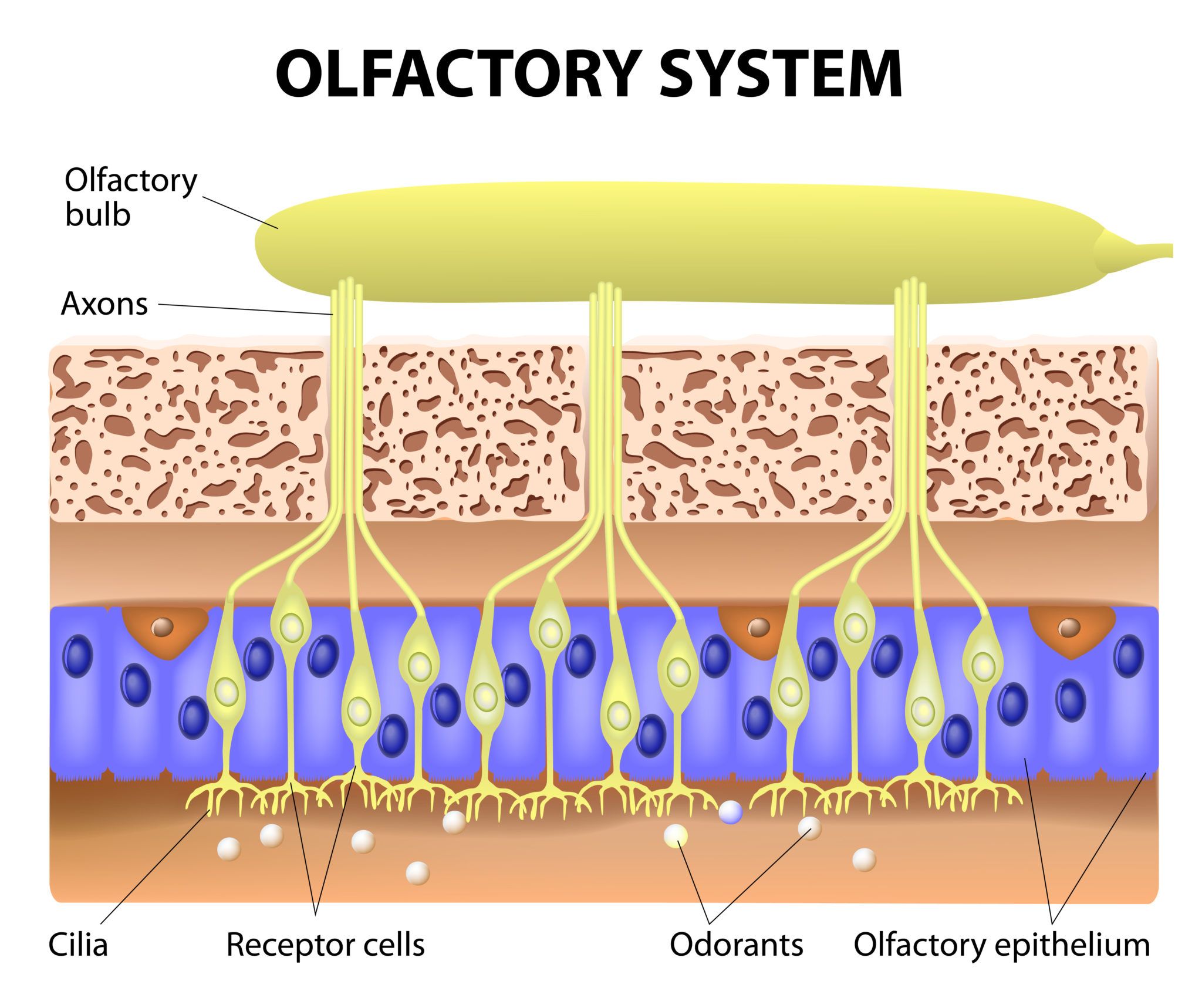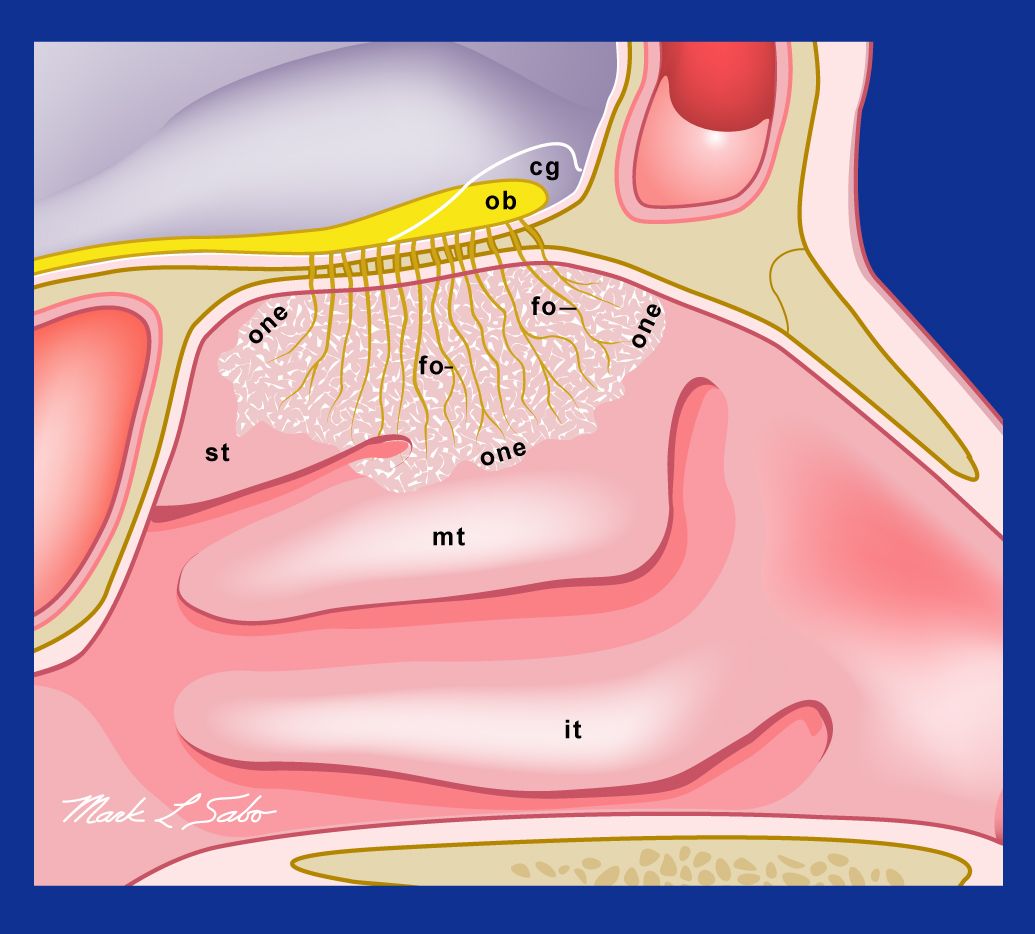Olfaction Disorder

Olfactory disorders can be classified as either the complete loss of capacity to detect odorants (anosmia) or distortions of the sense of smell. Patients may complain that a particular smell stimuli has an unpleasant odor or even the presence of a strange odor when a stimuli is absent. When objectively tested the prevalence of olfactory problems is around 20%.
Depending on the etiology the loss of olfaction can be classified into conductive or sensorineural loss. The most common causes of olfaction disorders include upper respiratory viral infections; sinusitis, head trauma; toxins/drugs, congenital causes, and idiopathic.
Conductive Olfactory Disorders
Problems with the sense of smell is one of the most common symptoms of rhinosinusitis. The presence of inflammation in the olfactory tract can block the deposition of odorants into the olfactory epithelium failing to produce the sensation that we know as smell. In addition, prolonged inflammation in the olfactory neuroepithelium could result in scarring and eventual sensorineural olfactory loss. Sinonasal tumors, can also cause obstruction of odorants and consequently conductive olfactory loss.

Sensorineural Olfactory Disorders
Loss of olfaction after an Upper Respiratory Viral Infection (URVI) is the most common cause of smell disorders. Initially the inflammation results in a conductive loss process but prospectively the virus is theorized to cause neural damage to the bipolar olfactory neurons. The exact mechanism of injury is unknown.The death of virally infected olfactory neurons may have a protective purpose by preventing the passage of viruses to the central nervous system (CNS). After the viral insult the likelihood of smell recovery decreases with increasing age, severity of loss, and duration of loss.
Congenital Loss
Congenital anosmia is usually an isolated finding. These patients often present during teenage years with an inability to smell, which is often discovered incidentally. However, associations exist between congenital anosmia and several abnormalities including Kallmann syndrome, holoprosencephaly and anterior neuropore anomalies.ion of loss.
Aging and Neurodegenerative Disorders
With increasing age, olfactory ability declines causing significant impairment in the quality of life of older patients. Twenty percent of people over 65 years of age experience smell dysfunction, this number increases to more than half by 80. Studies have shown that elders have less olfactory epithelium and a decreased size of the olfactory bulb.
In patients with Alzheimer and Parkinson diseases, 90% exhibit olfactory dysfunction in the early stages of the diseases. Olfactory disturbances may be the first clinical indication of neurodegenerative diseases, preceding signs of dementia in Alzheimer disease (AD) or motor symptoms in Parkinson disease (PD) by several years.
Smell: Memory and Emotion
More than any of our other senses, the sense of smell is closely linked with memory. Smells evoke particular memories; for example the scent of a coconut conjuring up recollections of a day at the beach. Smell is also highly emotive. The perfume industry is built around this connection, with perfumers developing fragrances that seek to convey a vast array of emotions; from desire to relaxation.
Safety
Our sense smell works as a warning system for our bodies. Patients with a decrease or absent olfaction are at higher risk for accidents as a result of missing this cautioning sense. The greatest danger to these patient is their inability to detect natural gas or carbon dioxide emissions which could have deadly results. In addition, anosmic patients are enable to detect expired or bad food which predispose them to food poisoning. No less important is that anosmic sufferers can be unaware of their own body odors affecting their own personal hygiene.
Safety Tips for Anosmia Sufferers
- Get a natural gas and CO2 detector.
- Check your gas appliances by a professional every year.
- Pay attention to expiration dates on food. Use labels with dates on any leftover and if in doubt, throw it out!
- Remember to eat regularly and monitor your weight in case it declines due to loss of appetite.
Olfactory Training
Similar to the muscle increasing in size by weight-lifting, the sense of smell can be improved by training it. Studies in recent years have shown that repeated short-term exposure to odors can be beneficial to patients affected by olfactory loss. We recommend the use of four different odorants in the form of essential oils (lemon, rose, clove and eucalyptus ) as a central piece of your olfactory training.










